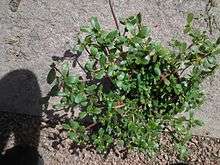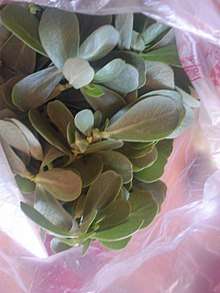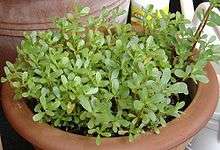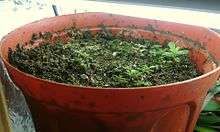Portulaca oleracea
| Portulaca oleracea | |
|---|---|
| Scientific classification | |
| Kingdom: | Plantae |
| Clade: | Angiosperms |
| Clade: | Eudicots |
| Order: | Caryophyllales |
| Family: | Portulacaceae |
| Genus: | Portulaca |
| Species: | P. oleracea |
| Binomial name | |
| Portulaca oleracea | |
Portulaca oleracea (common purslane, also known as verdolaga, red root, or pursley) is an annual succulent in the family Portulacaceae, which may reach 40 cm (16 in) in height.
Approximately forty cultivars are currently grown.[1]
Distribution
It has an extensive distribution, assumed to be mostly anthropogenic,[2] throughout the Old World extending from North Africa and Southern Europe through the Middle East and the Indian subcontinent to Malesia and Australasia. The species status in the New World is uncertain: in general, it is often considered an exotic weed, however, there is evidence that the species was in Crawford Lake deposits (Ontario) in 1350–1539, suggesting that it reached North America in the pre-Columbian era. Scientists suggested that the plant was already eaten by native Americans, who spread its seeds. How it reached the New World is currently unknown.[3]
Description

It has smooth, reddish, mostly prostrate stems and the leaves, which may be alternate or opposite, are clustered at stem joints and ends.[4] The yellow flowers have five regular parts and are up to 6 mm (0.24 in) wide. Depending upon rainfall, the flowers appear at any time during the year. The flowers open singly at the center of the leaf cluster for only a few hours on sunny mornings. Seeds are formed in a tiny pod, which opens when the seeds are mature. Purslane has a taproot with fibrous secondary roots and is able to tolerate poor compacted soils and drought.
History
Widely used in East Mediterranean countries, archaeobotanical finds are common at many prehistoric sites. In historic contexts, seeds have been retrieved from a protogeometric layer in Kastanas, as well as from the Samian Heraion dating to seventh century BC. In the fourth century BC, Theophrastus names purslane, andrákhne (ἀνδράχνη), as one of the several summer pot herbs that must be sown in April (Enquiry into Plants 7.1.2).[5] As Portulaca it figures in the long list of comestibles enjoyed by the Milanese given by Bonvesin de la Riva in his "Marvels of Milan" (1288).[6]
In antiquity, its healing properties were thought so reliable that Pliny the Elder advised wearing the plant as an amulet to expel all evil (Natural History 20.210).[5]
A common plant in parts of India, purslane is known as sanhti, punarva, paruppu keerai (Tamil), gangavalli(Telugu) or kulfa (Hindi),
In Myanmar (Arakan)people known as Ti Kyate Hun.
Uses

Culinary
| Nutritional value per 100 g (3.5 oz) | |
|---|---|
| Energy | 84 kJ (20 kcal) |
|
3.39 g | |
|
0.36 g | |
|
2.03 g | |
| Vitamins | Quantity %DV† |
| Vitamin A | 1320 IU |
| Thiamine (B1) |
4% 0.047 mg |
| Riboflavin (B2) |
9% 0.112 mg |
| Niacin (B3) |
3% 0.48 mg |
| Vitamin B6 |
6% 0.073 mg |
| Folate (B9) |
3% 12 μg |
| Vitamin C |
25% 21 mg |
| Vitamin E |
81% 12.2 mg |
| Minerals | Quantity %DV† |
| Calcium |
7% 65 mg |
| Iron |
15% 1.99 mg |
| Magnesium |
19% 68 mg |
| Manganese |
14% 0.303 mg |
| Phosphorus |
6% 44 mg |
| Potassium |
11% 494 mg |
| Zinc |
2% 0.17 mg |
| Other constituents | Quantity |
| Water | 92.86 g |
|
| |
| |
|
†Percentages are roughly approximated using US recommendations for adults. Source: USDA Nutrient Database | |
Purslane may be eaten as a leaf vegetable.[7] William Cobbett noted that it was "eaten by Frenchmen and pigs when they can get nothing else. Both use it in salad, that is to say, raw".[8] It has a slightly sour and salty taste and is eaten throughout much of Europe, the Middle East, Asia, and Mexico.[1][9] The stems, leaves and flower buds are all edible. Purslane may be used fresh as a salad, stir-fried, or cooked as spinach is, and because of its mucilaginous quality it also is suitable for soups and stews. The sour taste is due to oxalic and malic acid, the latter of which is produced through the crassulacean acid metabolism (CAM) pathway that is seen in many xerophytes (plants living in dry conditions), and is at its highest when the plant is harvested in the early morning.[10]
Australian Aborigines use the seeds of purslane to make seedcakes. Greeks, who call it andrákla (αντράκλα) or glistrída (γλιστρίδα), use the leaves and the stems with feta cheese, tomato, onion, garlic, oregano, and olive oil. They add it in salads, boil it, or add it to casseroled chicken. In Turkey, besides being used in salads and in baked pastries, it is cooked as a vegetable similar to spinach, or is mixed with yogurt to form a Tzatziki variant.[11]
Companion plant
As a companion plant, purslane provides ground cover to create a humid microclimate for nearby plants, stabilising ground moisture. Its deep roots bring up moisture and nutrients that those plants can use, and some, including corn, will follow purslane roots down through harder soil that they cannot penetrate on their own.
Nutrition
Purslane contains more omega-3 fatty acids (alpha-linolenic acid in particular[12]) than any other leafy vegetable. Studies have found that purslane has 0.01 mg/g of eicosapentaenoic acid (EPA). It also contains vitamins (mainly vitamin A, vitamin C, vitamin E (alpha-tocopherol),[13] vitamin B, carotenoids), and dietary minerals such as magnesium, calcium, potassium, and iron.


Also present are two types of betalain alkaloid pigments, the reddish betacyanins (visible in the coloration of the stems) and the yellow betaxanthins (noticeable in the flowers and in the slight yellowish cast of the leaves). Both of these pigment types are potent antioxidants and have been found to have antimutagenic properties in laboratory studies.[14]
Cooked vs. raw
100 grams of fresh purslane leaves contain 300 to 400 mg of alpha-linolenic acid.[13] One cup (250 ml) of cooked leaves contains 90 mg of calcium, 561 mg of potassium, and more than 2,000 IUs of vitamin A.
Morning harvest vs. afternoon
When water is abundant, purslane performs photosynthesis mostly by C3 carbon fixation, which is more widespread in nature. When stressed by low availability of water, however, purslane, which has evolved in hot and dry environments, switches to photosynthesis using an alternative pathway, crassulacean acid metabolism (the CAM pathway). At night its leaves trap carbon dioxide, which is converted into malic acid (which is the souring principle of apples), and, in the day, the malic acid is converted into glucose. When harvested in the early morning, the leaves have ten times the malic acid content as when harvested in the late afternoon, and thus have a significantly more tangy taste. Opuntia cacti, which are eaten as a vegetable (known as nopales in Mexican cuisine), also employ the CAM pathway and are similarly best harvested in the early morning, though the pickled nopales sold commercially have citric or malic acids added to the pickling liquid.
Chemical constituents
Chemical constituents include noradrenaline, calcium salts, dopamine, L-DOPA, malic acid, citric acid, glutamic acid, asparagic acid, nicotinic acid, alanine, glucose, fructose, and sucrose.[15] Purslane also contains oxalic acid that makes it non-recommended in large quantities for people who have uric acid or kidney problems or must restrict dietary oxalate levels.[16]
Betacyanins isolated from Portulaca oleracea improved cognition deficits in aged mice.[17] A subclass of homoisoflavonoids from the plant showed in vitro cytotoxic activities towards four human cancer cell lines.[18]
In popular culture
- Purslane also finds mention in a translation of the Bible as a repulsive food. Job's question in Job 6:6 is translated in the Revised Standard Version as, "Can that which is tasteless be eaten without salt or is there any taste in the slime of the purslane?" whereas the King James Version translates this verse as "Can that which is unsavoury be eaten without salt? Or is there any taste in the white of an egg?"
- The name verdolaga, associated with the plant that grows in South America, is a nickname for football clubs with green-white schemes in their uniforms, such as Colombia's Atletico Nacional and Argentina's Ferrocarril Oeste.
See also
References
- 1 2 Marlena Spieler (July 5, 2006). "Something Tasty? Just Look Down". The New York Times.
- ↑ "Portulaca oleracea (common purslane)". Go Botany. New England Wildflower Society.
- ↑ Byrne, R. & McAndrews, J.H. (1975). "Pre-Columbian puslane (Portulaca oleracea L.) in the New World" (PDF). Nature. 253 (5494): 726–727. doi:10.1038/253726a0. Retrieved 29 July 2016.
- ↑ Hilty, John (2016). "Common Purslane (Portulaca oleracea". Illinois Wildflowers. Retrieved 2018-02-05.
- 1 2 Megaloudi Fragiska (2005). "Wild and Cultivated Vegetables, Herbs and Spices in Greek Antiquity". Environmental Archaeology. 10 (1): 73–82. doi:10.1179/146141005790083858.
- ↑ Noted by John Dickie, Delizia! The Epic History of Italians and Their Food (New York, 2008), p. 37.
- ↑ Wright, Clifford A. (2012). "Purslane". Mediterranean Vegetables: A Cook's Compendium of All the Vegetables from the World's Healthiest Cuisine, with More Than 200 Recipes. Boston, Massachusetts: Harvard Common Press. pp. 276–277. ISBN 978-1-55832-775-7.
- ↑ Cobbett, William (1980). The English Gardener. Oxford: Oxford University Press. p. 126. ISBN 0192812920.
- ↑ Pests in Landscapes and Gardens: Common Purslane. Pest Notes University of California Agriculture and Natural Resources Publication 7461. October 2003
- ↑ Harold McGee. On Food and Cooking. Scribner. 2004 edition. ISBN 978-0684800011
- ↑ "Semizotlu Cacık – Hilal'in Mutfağı". Nefis Yemek Tarifleri (in Turkish). 2016-05-28. Retrieved 2017-08-07.
- ↑ Omara-Alwala, Thomas R.; Mebrahtu, Tadesse; Prior, Debra E.; Ezekwe, Michael O. (March 1991). "Omega-three fatty acids in purslane (Portulaca oleracea) Tissues". Journal of the American Oil Chemists' Society. 68 (3): 198–199. doi:10.1007/BF02657769.
- 1 2 Simopoulos, A P; Norman, H A; Gillaspy, J E; Duke, J A (August 1992). "Common purslane: a source of omega-3 fatty acids and antioxidants". Journal of the American College of Nutrition. 11 (4): 374–382. doi:10.1080/07315724.1992.10718240. PMID 1354675.
- ↑ "Evaluation of the Antimutagenic Activity of Different Vegetable Extracts Using an In Vitro Screening Test" (PDF). westernpharmsoc.org.
- ↑ Tierra, C.A., N.D., Michael (1988). Planetary Herbology. Lotus Press. p. 199.
- ↑ "Kidney stones - TriHealth: Discover the Power of Unity". trihealth.adam.com. Retrieved 2018-10-14. line feed character in
|title=at position 14 (help) - ↑ Wang, CQ. Yang GQ. (2010). "Betacyanins from Portulaca oleracea L. ameliorate cognition deficits and attenuate oxidative damage induced by D-galactose in the brains of senescent mice". Phytomedicine. 17 (7): 527–532. doi:10.1016/j.phymed.2009.09.006. PMID 19879120.
- ↑ Yan, J; Sun, LR; Zhou, ZY; Chen, YC; Zhang, WM; Dai, HF; Tan, JW (Aug 2012). "Homoisoflavonoids from the medicinal plant Portulaca oleracea". Phytochemistry. 80: 37–41. doi:10.1016/j.phytochem.2012.05.014. PMID 22683318.
External links
| Wikimedia Commons has media related to Portulaca oleracea. |
| Wikispecies has information related to Portulaca oleracea |
- Portulaca oleracea in West African plants – A Photo Guide.
- Purslane Recipes, Prairieland Community Supported Agriculture